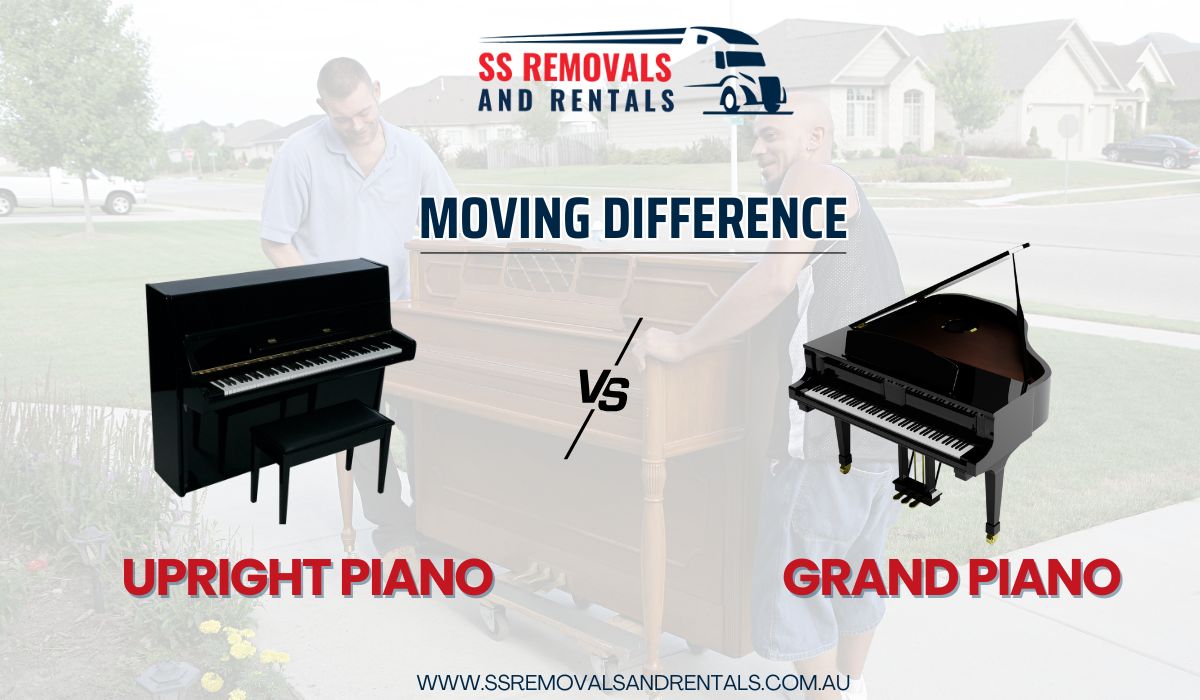Moving a piano is never a simple task. These magnificent instruments, whether a compact upright or a majestic grand, are heavy, delicate, and often oddly shaped. But does the type of piano you own significantly impact the moving process? The answer is a resounding yes! While both require professional movers with specialized equipment, the challenges and methodologies differ considerably.
Let’s break down the key distinctions when moving an upright versus a grand piano.
Moving an Upright Piano: The “Vertical Challenge”
Upright pianos, encompassing spinets, consoles, studio, and professional uprights, are characterized by their vertical design. While they occupy less floor space than grands, their weight is concentrated in a tall, narrow form.
Key considerations for moving an upright:
- Weight Distribution: The weight is primarily in the back, making them prone to tipping if not handled correctly.
- Stairs and Tight Spaces: Their upright nature can be an advantage in narrower hallways and around corners, but stairs still pose a significant challenge. Specialized piano dollies and straps are crucial to navigate these obstacles safely.
- Protection: The finish can be easily scratched, and the internal mechanisms are susceptible to jarring. Proper padding, blankets, and shrink wrap are essential to protect the cabinet and internal components.
- Legs and Pedals: While more robust than grand piano legs, they still need protection from impact.
For those planning a local or even a long distance moving journey for their upright, professional removalists understand these specific challenges. They ensure the piano is expertly prepared for the journey, whether it’s across town or to a new city. You can learn more about how experienced removalists handle pianos and other special items.
The Upright Moving Process (Simplified):
Typically, an upright will be secured onto a heavy-duty piano dolly. Movers will then use specialized straps and proper lifting techniques to maneuver it through doorways and onto the moving truck. For stairs, piano skids or stair-climbing dollies are often employed, along with multiple movers to control the descent or ascent.
Moving a Grand Piano: The “Horizontal Hurdles”
Grand pianos – baby grands, medium grands, and concert grands – are the epitome of elegance, but their unique shape presents a different set of moving complexities.
Key considerations for moving a grand:
- Disassembly: This is the most significant difference. Grand pianos must be partially disassembled before moving. This involves carefully removing the legs, pedals, and often the music desk and lid. Each piece needs to be individually wrapped and secured.
- Size and Weight: Even a baby grand is considerably wider and often heavier than most uprights. Their large footprint requires ample space for maneuvering.
- Delicate Legs: The elegant, often ornate legs are surprisingly fragile and are designed to bear vertical weight, not lateral stress. They are highly susceptible to breaking if the piano is not properly supported during moving.
- Soundboard and Lyre: The soundboard is the heart of the piano, and the pedal lyre (the structure holding the pedals) is also delicate. Both need meticulous protection.
- Specialized Equipment: A grand piano skid board (or piano board) is indispensable. The piano is carefully tilted onto its side on this board, secured with straps, and then moved.
Whether you’re relocating within a city or undertaking interstate moves to a distant location, the process for a grand piano is significantly more involved. This complexity is why seeking affordable removalists who specialize in pianos is critical, as they possess the specific tools and expertise.
The Grand Moving Process (Simplified):
1.Disassembly: Legs, pedals, and often the lid are removed and individually wrapped.
2.Tilting onto Skid Board: The main body of the piano is carefully tilted onto a specialized padded grand piano skid board.
3.Securing: The piano is securely strapped to the skid board to prevent any movement.
4.Maneuvering: Using the skid board and heavy-duty dollies, the piano is carefully rolled and pivoted through doorways and onto the truck. For stairs, this is an even more intricate process, often requiring a larger team and specialized equipment.
The Verdict: Professional Help is Non-Negotiable
Regardless of whether you own an upright or a grand, one thing remains constant: never attempt to move a piano yourself. Pianos are incredibly heavy, easily damaged, and can cause serious injury if not handled by trained professionals.
Professional piano movers have:
- The Right Equipment: Specialized dollies, skids, straps, blankets, and tools designed for piano transport.
- The Expertise: Knowledge of how to properly disassemble, wrap, lift, and maneuver pianos of all types, minimizing risk to the instrument and themselves.
- Insurance: Protecting your valuable instrument in the unlikely event of an accident.
While moving a grand piano generally involves more steps, specialized equipment, and often a larger crew, making it typically more expensive, both types of pianos demand a high level of care and expertise. Understanding these differences can help you appreciate the complex logistics involved and reinforce the importance of entrusting your cherished instrument to the hands of professionals.
Looking for affordable piano movers who care as much about your instrument as you do? Trust professionals like SS Removals and Rentals who understand the complexity of transporting pianos, antiques, and other cherished possessions.



